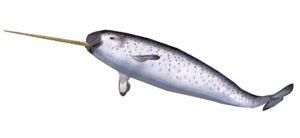Our Select specialists are often called in to assist in the valuation of some of the most esoteric items one can imagine. In this case, we were called in to appraise an item out of legend – the tusk of a “Sea Unicorn,” better known as a narwhal.
In actuality, though they are endangered, narwhals are not creatures of fantasy like their storybook peer the unicorn. The narwhal, or narwhale, is a medium sized whale and close relative of the beluga whale. They are found primarily in the arctic waters of Canada, Greenland and Russia. Male narwhals (and a few females) have a spiral tusk that can grow over eight feet long. Unlike the fabled “unicorn’s horn”, the tusk is actually an extension of a tooth protruding from the left side of a narwhal’s mouth. This tusk of natural ivory is highly praised both as a carving material and a trophy.

Our team was called in to establish value of a six-foot long tusk that was stolen from the policyholder, with an insured stated value of $40,000.
Unfortunately the policyholder had no pricing documentation, and the only photo of the item was that of a similar tusk to his, but not of the stolen tusk. The policyholder did share with us that the tusk was procured approximately 20 years ago at the purchase price of $10,000.
Armed with scant information, our specialists began to research the rare item. Typically, the value of authentic narwhal tusks is established by a number of key factors, including the length of the tusk, whether it is straight or curved, if the tip is damaged or broken off, as well as how pronounced the helical nature, or spiral is.
Communicating with the policyholder as well as analyzing the photograph, we were able to establish the above value factors, and our research then took us to the marketplace, including auction houses and dealers to determine values of like, kind and quality items. With extensive research, we were able to establish the value of a vintage replacement at $17,000.
Unfortunately, the complexity doesn’t end here.
Once the key details were confirmed, an age was attributed, and a value established, our team had one further, and extremely important fact, to research – the determination of the legality of the tusk.
CITES, short for the “Convention of International Trade in Endangered Species of Wild Fauna and Flora,” is an international agreement with the stated goal of protecting animals and plants from endangerment by limiting their trade.
In addition to CITES, as an ivory producing “marine animal,” narwhals are also protected under the North Atlantic Marine Mammal Commission (NAMMCO) and the International Whaling Commission (IWC), as well as the International Union for Conservation of Nature (IUCN).
It was necessary for our team to research all of these agencies in order to determine if the tusk was contraband. The CITES convention bans the sale of parts of animals such as hides, furs, antlers, tusks, and much more. The illegal smuggling of banned items is big business. This past March, a New Brunswick, Canada man, an ex-Mountie, was extradited to the US for smuggling more than 250 narwhal tusks into the US with a value of over two million dollars. Indeed, big business!
Without any formal documentation, we had to presume the legality of the tusk based on the assumption that its origination to the US was prior to the 1972 CITES ban on ivory tusks. The policyholder claimed that the tusk was brought to the states prior to 1940, and therefore free of any sanctions.
In this case, we established the value of the legally owned tusk to be $17,000.
 Scott Lacourse is a director at Enservio, www.enservio.com, a provider of contents claim software, payments solutions, inventory and valuation services for property insurers. You can contact him at slacourse@enservio.com.
Scott Lacourse is a director at Enservio, www.enservio.com, a provider of contents claim software, payments solutions, inventory and valuation services for property insurers. You can contact him at slacourse@enservio.com.
Read other articles by Scott Lacourse:
Using Key Value Factors to Evaluate Vinyl Records
Key Factors for Determining Cigar Value
Using Key Value Factors to Evaluate First Edition and Rare Books
Was this article valuable?
Here are more articles you may enjoy.

 Group Sues California Department of Insurance Over FAIR Plan Surcharges
Group Sues California Department of Insurance Over FAIR Plan Surcharges  Uber Sued by FTC Over ‘Deceptive’ Subscription Sign-Ups
Uber Sued by FTC Over ‘Deceptive’ Subscription Sign-Ups  As Trump Considers Auto Tariffs Pause, Parts Exemptions Could Be Key for US Industry
As Trump Considers Auto Tariffs Pause, Parts Exemptions Could Be Key for US Industry  Report: Insurers Pay $1.6B in Dog Bite Claims, as Frequency Soars
Report: Insurers Pay $1.6B in Dog Bite Claims, as Frequency Soars 